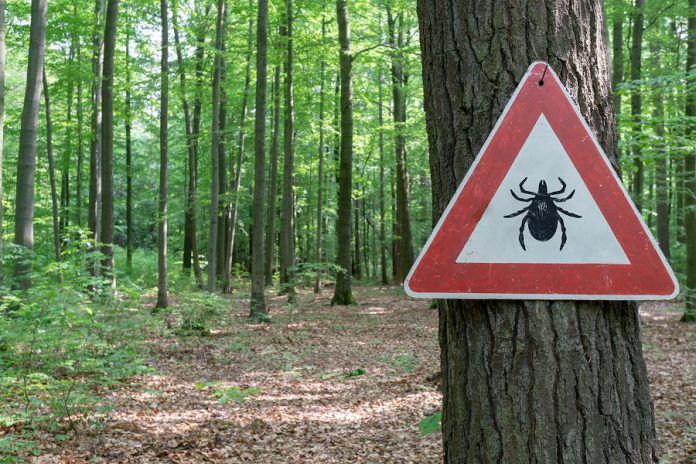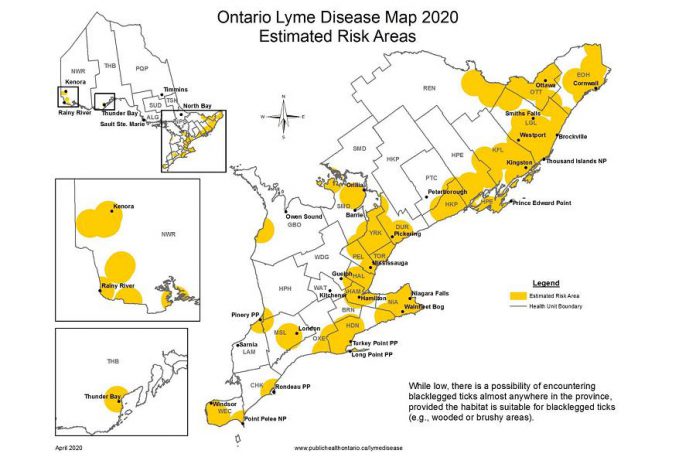
Peterborough Public Health has identified a tick infected with the bacterium that causes Lyme disease — the first one this season. The infected tick was discovered as part of the health unit’s recent surveillance work in Petroglyphs Provincial Park.
The blacklegged tick (Ixodes scapularis, also known as deer ticks) is the only species in Ontario that hosts the bacterium (Borrelia burgdorferi) that causes Lyme disease.
“The National Microbiology Laboratory confirmed that a blacklegged tick found in our area has tested positive for Lyme disease,” says Peterborough Public Health manage of environmental programs Julie Ingram. “This serves as a good reminder to be tick smart and take precautions when going into any wooded and grassy areas, especially those with known tick populations.”
The health unit will be conducting additional surveillance in Petroglyphs Provincial Park this fall. If more infected blacklegged ticks are identified from the same location, this information will inform Public Health Ontario’s map of estimated risk areas for Lyme disease in Ontario.
Residents are encouraged to monitor themselves for ticks, and to use the eTick website at etick.ca to submit a photo of a tick to find out if it’s a blacklegged tick. You can also use eTick’s free mobile app, available on Google Play and the Apple App Store. Once you submit a photo, the identification results will be available within 48 hours. Real-time mapping of tick submissions is also shown on the website.
If you can’t use the eTick website or app, you can submit a tick for testing to Peterborough Public Health. When bringing a tick to Peterborough Public Health, be aware that only ticks found on humans will be submitted for identification and testing. Any ticks found on pets or other animals should be taken to a veterinarian.

Preventing tick bites
The best way to prevent Lyme disease is to avoid getting bitten by ticks in areas where they live, such as tall grasses and wooded habitats.
Before heading out, wear long and light-coloured clothing and tuck pant legs into socks. Spray an insect repellent containing DEET on your clothes. Check for ticks when you return from the outdoors, and it’s a good idea to shower after you get home to wash off any ticks that may be crawling on your body.
The signs of Lyme disease can be categorized in three stages. However, the first sign is usually a circular rash in the shape of a bull’s eye. Other symptoms include fever, chills, headache, muscle and joint pain, fatigue, and swollen lymph nodes.
What to do if you find a tick
Ticks can be as small as a sesame seed and their bites are usually painless. If you do locate a tick on your body, use fine-tipped tweezers to grasp the tick as close to your skin as possible and pull the tick straight out. Removing the tick within 24 hours is key to preventing Lyme disease infection.
The best and quickest way to determine if the tick is the species that carries Lyme disease is to use the eTick app or website.
Lyme disease has gained the attention of health officials because cases in Ontario are increasing. In 2019, residents submitted approximately 280 ticks to Peterborough Public Health for identification and testing.

While final analysis of results from submissions later in the year are pending, of the 23 ticks that were confirmed positive for Lyme disease between January to June 2019,, five of those came from Peterborough County.
Lyme disease is a potentially serious illness and growing health risk across Ontario. It is caused by the bite of infected blacklegged ticks. While not all blacklegged ticks carry Lyme disease, populations of infected blacklegged ticks are spreading throughout Ontario. Some southern areas of the geographical area serviced by Peterborough Public Health have been identified as a risk area by Public Health Ontario.



























